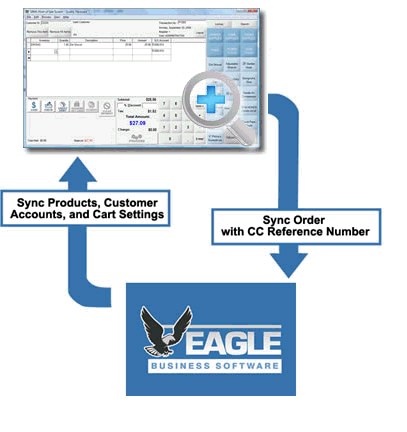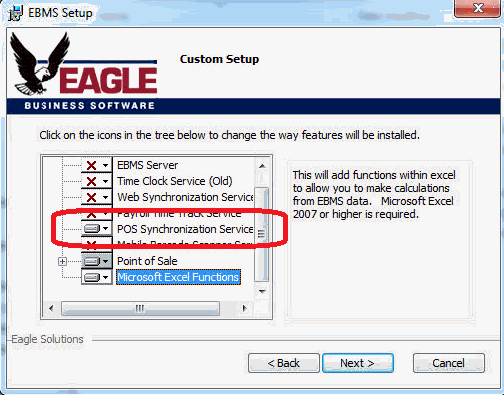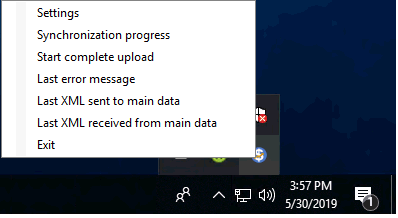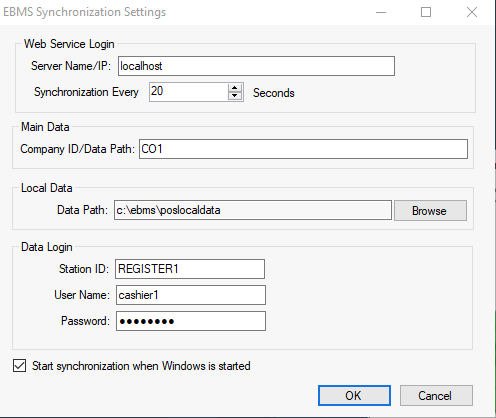- EBMS Knowledge Base
- Sales
- Point of Sale | Advanced Tools
-
Client Resources
-
EBMS Main Documentation
- Introduction
- Getting Started
- Getting Started | Initial Installation
- Getting Started | Company Setup
- Quick User Guide | Financial Staff | Accountant
- Quick User Guide | Financial Staff | Accountant | Accountants Journal
- Quick User Guide | Sales Staff
- Quick User Guide | General Staff
- Features
- Reports
- Reports | Excel Add-In
- Reports | Excel Add-In | Troubleshooting
- Security
- Server Manager
- Technical
- Technical | Data Import and Export Utility
- Technical | SQL Mirror
- Automotive
- Automotive | Parts Catalog
- Automotive | Pricing
- Automotive | Point of Sale
- Automotive | Product Application
- Automotive | Keystone Interface
- Metal Supply
- Fuel Sales
- Horticulture
- Horticulture | Farm Setup
- Horticulture | Processing Payroll
- Horticulture | Managing the Farm
-
Sales
- Introduction
- Customers
- Customers | Miscellaneous Customers
- Proposals
- Proposals | Processing Proposals
- Proposals | Sets and Templates
- MyProposals
- MyOrders
- Sales Orders
- Invoices
- Materials Lists
- Sales and Use Tax
- Sales and Use Tax | TaxJar
- CRM
- CRM | Auto Send
- Recurring Billing
- Credits
- Customer Payments
- Payment Card Processing
- Payment Card Processing | Gift Cards
- Payment Card Processing | Loyalty Cards
- Payment Card Processing | Verifone Gateway
- Freight and Shipping Tools
- General Ledger Transactions
- Point of Sale
- Point of Sale | Point of Sale Hardware
- Point of Sale | Xpress POS System
- Point of Sale | Advanced Tools
- Signature Capture
- Salesperson Commissions
-
Inventory
- Product Catalog
- Product Catalog | Using Product Codes for No Count Items
- Product Pricing
- Product Pricing | Special Pricing
- Tracking Counts
- Unit of Measure
- Purchasing
- Special Orders and Drop Shipped Items
- Receiving Product
- Barcodes
- MyInventory and Scanner
- Components (BOM) and Accessories
- Components (BOM) and Accessories | Component Formula Tool
- Made-to-Order Kitting
- Configure-to-Order Kitting
- Multiple Inventory Locations
- Multiple Inventory Locations | Creating Locations
- Multiple Inventory Locations | Using Multiple Locations
- Multiple Inventory Locations | Product Catalog Sync
- Multi-Vendor Catalog
- Serialized Items
- Serialized Items | Purchasing or Manufacturing an Item
- Serialized Items | Selling and/or Associating an item with a customer
- Lots
- Product Attributes
- Product Attributes | Selling and Purchasing Items with Attributes
- Product Attributes | Custom Attributes
- Mobile Scanner (Legacy)
-
Labor
- Getting Started
- Workers
- Taxes and Deductions
- Work Codes
- Time and Attendance
- Time and Attendance | Time Track App
- Processing Payroll
- Closing the Payroll Year
- Processing Payroll - Advanced
- Salaried Pay
- Piecework Pay
- Direct Deposit
- 3rd Party Payroll Service
- Subcontract Workers
- Flag Pay
- Prevailing Wages
- MyDispatch
- MyTasks
- MyTime
- MyTime | Communications
- MyTime | Setup
- Tasks
- Tasks | Getting Started
- Tasks | Creating Tasks
- Tasks | Scheduling Tasks
- Tasks | Customizing Task Views
- Tasks | Managing Tasks
-
Financials
- Introduction
- Fiscal Year
- Chart of Accounts
- Budget
- Financial Reporting
- Transactions and Journals
- Transactions and Journals | Journals
- Account Reconciliation
- 1099
- Departments and Profit Centers
- Fund Accounts
- Bank Accounts
- Bank Feed
- Vendors
- Vendors | Miscellaneous Vendors
- Purchase Orders
- Expense Invoices
- Vendor Payments
- AP Transactions
- Landed Cost
- Fixed Assets and Depreciation
- Fixed Assets and Depreciation | Fixed Assets
- Fixed Assets and Depreciation | Fixed Assets | Adding Assets
- Fixed Assets and Depreciation | Processing Depreciation
- Fixed Assets and Depreciation | Disposing Assets
- MyJobs
-
E-commerce
-
Rental
-
Job Costing
-
Manufacturing
Sync Tool Overview
The Synchronization tool is an EBMS enhancement that allows the XPress POS to operate independently of the main EBMS database or server. The Xpress POS can operate on a POS machine as a stand alone software and update sales and order details when the network is established. The Sync tool is useful in the following situations:
-
The Xpress POS station is needed in a remote location without a current network to the EBMS software: This scenario is common for a portable POS at an event, temporary location, or a show.
-
POS is needed at a secondary location that does not include high speed network connections to the main location
-
A high speed POS solution is needed that will operate efficiently without possible performance delays because of an internal data network.
The Sync tool allows a user to operate a POS station even if the local area network is down or is experiencing performance issues.
-
The Sync tool must be installed from the EBMS installation utility as shown below.

-
Complete EBMS setup wizard to install the Sync tool. Review [Main] Initial Installation section for instructions on adding features during setup.
Client Options
Click on the EBMS Synchronization icon found on the computer task bar tray as shown below:

Click on the Settings option to open the following dialog:

-
Set the location of the main EBMS data by setting the Server Name/IP setting and the Company ID/Data Path settings. Review these technical settings with IT staff or EBMS support personnel.
-
Configure the Synchronization timing. This option will cause the Sync tool to attempt a connection based on the timing settings.
-
Set the Data Path of the local XPress POS data on the local POS station.
-
Set the following Data Login settings to allow access to local data and Sync to the main server:
-
The Station ID must reflect the point of sale station profile ID as setup in EBMS. See XPress POS System > Configure POS Profiles for setup instructions.
-
Enter the EBMS login User Name and Password. See [Main] Security > Creating Users and Assigning Rights for details on creating EBMS user name and passwords.
-
Enable the Start synchronization... option so that the sync tool runs when a POS station is started.
Click OK to save the client settings
The following tools can be accessed from the client's task bar tray:
-
Synchronization Progress: Select this option to review the status or progress of the Sync tool.
-
Start Complete Upload: Use this option to push all information to the server. This step will verify that all data has been communicated to EBMS and that all data on the client is current.
EBMS Server options
The status of the synchronization of each remote station can be viewed by selecting File > Synchronization Status from the main EBMS menu as shown below:

WARNING: It is important that sales invoices created by xPress POS and synchronized to EBMS are not altered or deleted in the main EBMS data until the synchronization process is complete.
Notice that the status of changes pushed to the client (Main -> Remote) and the changes pushed from the client to EBMS (Remote -> Main) are shown. Additional information is shown on the log pane for each station that is highlighted.
